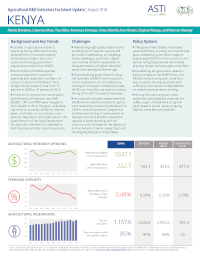Authors:
Nienke Beintema, Lawrence Mose, Titus Kibet, Rosemary Emongor, Festus Murithi, Irene Kimani, Virginia Ndungu, and Peterson Mwangi
Year:
2018
Publisher
International Food Policy Research Institute and Kenya Agricultural and Livestock Research Organization
Back to:
Background and key trends
- Growth in agricultural research spending during 2000-2016 mostly stemmed from increased capacity within Kenya’s higher education sector and among government organizations other than KALRO.
- Both KEFRI and KMFRI reported substantial growth in both their spending and researcher numbers. As a result, forestry and fisheries’ share of agricultural research rose from 12 percent in 2008 to 18 percent in 2016.
- In efforts to improve the coordination and efficiency of resource use, KARI, KESREF, CRF, and TRFK were merged to form KALRO in 2014. The goal-following the trend in countries like Brazil, Mexico, Japan, and India 0 is to promote cross-sectoral integration and collaboration. The establishment of the State Department for Agricultural Research is intended to both facilitate and fast track this process.
KALRO’s challenges
- Maintaining high-quality research and avoiding loss of research capacity will be crucial in addressing, or mitigating, future challenges, given that a significant number of senior researchers in the government and higher education sectors are nearing retirement age.
- Given declining government funding, the cessation of EAAPP, and the government’s reallocation of commodity-levy funding to nonresearch-related activities, KALRO was forced to use reserve funding during 2015-2017 to meet its expenses.
- An internal evaluation determined that KALRO would need to increase its agricultural researcher numbers by 40 percent to fulfill its research potential. Despite this, and the recent hiring of some interns on one-year contracts, KALRO’s researcher capacity is slowly declining and will continue to do so based on the departure and retirement of senior researchers and the ongoing long-term hiring freeze.
Policy options
- The government research institutes need solid hiring, training, and mentorship plans, backed by government support. Exempting KALRO from the country’s civil service hiring freeze would also enable pressing human resource gaps to be filled.
- Establishing an agricultural research fund according to the NARS Policy and KALRO’s restructuring plan could be a way to secure the organization’s self-sufficiency and reduce its dependence on volatile external donor funding.
- Having the national government reallocate commodity-tax revenues for coffee, sugar, and tea back to agricultural research would secure ongoing R&D for these key commodities.
- Work with the national government to reallocate commodity-tax revenues for coffee, sugar, and tea back to agricultural research in order to secure ongoing R&D for these key commodities

